Astronomical Orbital Cycle-Driven Coevolution of Paleoclimate and Sea Level with Sedimentary Response: A Case Study from the Upper Member of the Miocene Zhujiang Formation in the Enping Depression, South China Sea
Abstract
1. Introduction
2. Regional Geological Setting
3. Materials and Methods
3.1. Paleoclimate Proxies
3.2. Geochemical Information
3.3. Cyclostratigraphic Analysis
3.4. Reconstruction of Relative Sea-Level Change
4. Results
4.1. Time Series Analysis
4.2. Astronomical Chronology Analysis
4.3. Sedimentary Noise Modeling and Astronomical Forcing
4.4. Paleoclimate Indicators
5. Discussion
5.1. Paleoclimate Change Under Astronomical Forcing
5.2. Sea-Level Fluctuations Under Astronomical Forcing
5.3. Sedimentary Patterns Driven by Astronomical Orbital Cycles
6. Conclusions
- (1)
- Based on the principles of cyclostratigraphy, the Milankovitch cycle signals preserved in the 15.98–19.09 Ma stratigraphic sequence of the Upper Zhujiang Formation in the Enping Depression have been extracted systematically by using spectral analysis, wavelet transform, and astronomical tuning techniques of natural gamma-ray loggings. Through sliding window spectral analysis and dynamic correction of sedimentation rates, an astronomical age scale containing 405 kyr long eccentricity, 100 kyr short eccentricity, 40 kyr obliquity, and 20 kyr precession cycles was successfully constructed. Its resolution is more accurate than that of traditional biostratigraphy, and it provides a key calibration standard for high-precision isochronous stratigraphic correlation of the Neogene in the northern South China Sea.
- (2)
- The inversion results based on the DYNOT orbital period decomposition algorithm and ρ1 sediment noise model show that the study interval has a significant 405 kyr long eccentricity period dominant characteristic relative to sea-level variation. The quantitative correlation analysis between cycle thickness and sedimentary flux shows that the high value period of long eccentricity (corresponding to a high insolation phase) is coupled with the warm and wet period of global climate, which promotes the extensive deposition of fine mudstone under the background of transgression, while the low value period (low insolation phase) triggers the regional dry and cold climate, enhances the supply of terrigenous debris, and forms the dominant sedimentary sequence of coarse delta-coastal sandstone. This law establishes a dynamic response model for the prediction of reserve-cap combination under the interaction of land and sea.
- (3)
- The correspondence between the constant elements indicating environmental changes and astronomical cycle curves reveals that the 405 kyr long eccentricity period regulates the “periodic modulation” effect of precession amplitude, and both of them affect environmental changes such as climate change, weathering intensity, and rainfall variation in the study area, further affecting the sedimentary process. During the period of high eccentricity, the intensity of monsoon precipitation and chemical weathering increased sharply due to the increase in precession amplitude, and the base level rose due to the retreat of the ice sheet, which significantly altered the spatial distribution of the denudation flux and the sedimentary system in the source area.
- (4)
- The methodology and high-resolution timescale presented here lay a foundation for future comparative studies of orbital-scale sedimentary responses in monsoon-dominated systems, both within SE Asia and globally. This study is constrained by its regional focus on a single borehole in the Enping Depression, limiting direct comparisons with contemporaneous SE Asian basins due to scarce orbital-scale datasets. The temporal resolution of the astronomical timescale may overlook sub-Milankovitch events, while model assumptions (e.g., DYNOT attributing noise solely to sea level) might oversimplify tectonic or diagenetic influences. The reliance on GR and geochemical proxies (CIA, Al2O3) could underrepresent complex climate feedbacks, and restricted data accessibility hinders full reproducibility. Future work should integrate multi-proxy analyses and expand to adjacent basins to enhance regional and global applicability.
Author Contributions
Funding
Institutional Review Board Statement
Informed Consent Statement
Data Availability Statement
Conflicts of Interest
References
- Berger, A. Milankovitch Theory and climate. Rev. Geophys. 1988, 26, 624–657. [Google Scholar] [CrossRef]
- Berger, A. Milankovitch, the father of paleoclimate modelling. Clim. Past 2021, 17, 123–145. [Google Scholar] [CrossRef]
- Imbrie, J. Astronomical theory of the Pleistocene ice ages: A brief historical review. Icarus 1982, 50, 408–422. [Google Scholar] [CrossRef]
- Berger, A.; Loutre, M.F. Astronomical Forcing Through Geological Time. In Orbital Forcing and Cyclic Sequences; De Boer, P.L., Smith, D.G., Eds.; Blackwell Scientific Publications: Oxford, UK, 1994; pp. 15–38. [Google Scholar]
- Laskar, J.; Robutel, P.; Joutel, F.; Gastineau, M.; Correia, A.C.M. A long-term numerical solution for the insolation quantities of the Earth. Astron. Astrophys. 2004, 428, 261–285. [Google Scholar] [CrossRef]
- Laskar, J.; Fienga, A.; Gastineau, M.; Manche, H. La2010: A new orbital solution for the long-term motion of the Earth. Astron. Astrophys. 2011, 532, 784–785. [Google Scholar] [CrossRef]
- Hinnov, L.A. Cyclostratigraphy and its revolutionizing applications in the earth and planetary sciences. Geol. Soc. Am. Bull. 2013, 125, 1703–1734. [Google Scholar] [CrossRef]
- Shi, H.; He, M.; Zhang, L.; Yu, Q.; Pang, X.; Zhong, Z.; Liu, L. Hydrocarbon geology, accumulation pattern and the next exploration strategy in the eastern Pearl River Mouth basin. China Offshore Oil Gas 2014, 26, 12–25. [Google Scholar]
- Shi, H.; Dai, Y.; Liu, L.; Jiang, H.; Li, H.; Bai, J. Geological characteristics and distribution model of oil and gas reservoirs in Zhu I depression, Pearl River Mouth Basin. Acta Pet. Sin. 2015, 36, 120–133+155. [Google Scholar]
- Liu, Y.; Wu, H.; Zhang, S.; Fang, N. Cyclostratigraphy Research on the Hanjiang-Wanshan Formations in Zhuyi Depression, Pearl River Mouth Basin. Earth Sci. 2012, 37, 13. [Google Scholar]
- Zhu, C.; Zhang, S.; Wang, Y.; XU, E. Cyclical stratigraphic analysis and establishment of astronomical chronograph of Hanjiang Formation in Lufeng Sag. Mar. Geol. Front. 2022, 38, 11. [Google Scholar]
- Wang, H.; Dai, J.; Chai, Y.; Heng, L.; Song, G.; Sun, S.; Ni, R. Detailed Characterization of Neogene Relative Sea Level Change in Pearl River Mouth Basin and Its Control over Delta Sedimentary Evolution:Taking Hanjiang Formation and Zhujiang Formation of Oilfield A in Enping Sag as an Example. J. Jilin Univ. (Earth Sci. Ed.) 2024, 54, 359–370. [Google Scholar] [CrossRef]
- Li, Z.; Ding, L.; Li, X.; Li, X.; Wu, Y. Division of high-resolution stratigraphy in sedimentary sequence theory and prediction of lithological traps: A case study of the Neogene in Enping Sag, Pearl River Mouth Basin. Mar. Geol. Front. 2023, 39, 73–82. [Google Scholar] [CrossRef]
- Sun, Z.; Pang, X.; Zhong, Z.; Zhou, D.; Chen, C.; Hao, H. Dynamics of Tertiary tectonic evolution of the Baiyun Sag in the Pearl River Mouth Basin. EarthScience Front. 2005, 12, 10. [Google Scholar]
- Liu, H. Rift Style Controlled by Basement Attributeand Regional Stress in Zhu I Depression, Pearl River Mouth Basin. Earth Sci. 2018. [Google Scholar]
- Ma, L.; Shan, X.; Xiang, X.; Hao, G.; Zhang, P.; Yan, B.; Yi, B. Fault Activity and Dynamic Mechanisms During theRifting Stage in the Baiyun Depression of the Pearl River Mouth Basin. J. Jilin Univ. (Earth Sci. Ed.) 2024, 54, 1968–1985. [Google Scholar]
- Liu, Y.; Wu, Z.; Cheng, Y.; Wu, K.; He, M.; Zhang, J.; Chen, M. Spatial and temporal difference of Paleogene rift structure and its controlling factors in the northern South China Sea:A case study of Pearl River Mouth basin. J. China Univ. Min. Technol. 2019, 48, 367–376. [Google Scholar]
- Wang, C. The analysis of marine Neogene sequence stratigraphy in the Zhujiangkou Basin and its significance. China Offshore Oil Gas 1996, 10, 10. [Google Scholar]
- Wang, J.; Jin, S.; Wei, X.; Hao, J.; Chen, Y.; Li, L.; Ma, C. Orbital cycle recognition and sequence stratigraphic divisionof the Lower Carboniferous Dawuba Formation shales in Southwest Guizhou. Bull. Geol. Sci. Technol. 2024. [Google Scholar]
- Zhang, X.; Wu, J.; Peng, G.; Xu, X.; Zhen, X. Miocene river-wave dominated sedimentary system in south belt of Enping Sag and its significance. Lithol. Reserv. 2022, 34, 95–104. [Google Scholar]
- Du, W.; Zhu, R.; Xiong, L.; Zhu, H.; Shu, Y.; Huang, Z. Analysis of provenance systems of the EnpingFormation in the Enping sag, Pearl River Mouth basin and future ocean drilling proposals. Acta Geol. Sin. 2022, 96, 12. [Google Scholar]
- DU, W.; Ji, Y.; Ji, M.; Jin, Z.; Hao, L. Establishment and significance of high-resolution Early Oligocene chronostratigraphic framework in Raoyang Sag, Bohai Bay Basin. J. China Univ. Pet. (Ed. Nat. Sci.) 2020, 44, 10. [Google Scholar]
- Wu, H.; Zhang, S.; Feng, Q.; Fang, N.; Yang, T.; Li, H. Theoretical Basis Research Advancement and Prospects of Cyclostratigraphy. Earth Sci. J. China Univ. Geosci. 2011, 36, 20. [Google Scholar]
- Li, M.; Huang, C.; Ogg, J.; Zhang, Y.; Hinnov, L.; Wu, H.; Chen, Z.Q.; Zou, Z. Paleoclimate proxies for cyclostratigraphy: Comparative analysis using a Lower Triassic marine section in South China. Earth Sci. Rev. 2019, 189, 125–146. [Google Scholar] [CrossRef]
- Wu, H.; Zhang, S.; Jiang, G.; Huang, Q. The floating astronomical time scale for the terrestrial Late Cretaceous Qingshankou Formation from the Songliao Basin of Northeast China and its stratigraphic and paleoclimate implications. Earth Planet. Sci. Lett. 2009, 278, 308–323. [Google Scholar] [CrossRef]
- Zhao, Q.; Wu, H.; Li, H.; Zhang, S. Determining optimal sampling intervals for cyclotron analysis using the sampling theorem and deposition rates. Earth Sci. 2011, 36, 12–16. [Google Scholar]
- Li, M.; Hinnov, L.; Kump, L. Acycle: Time-series analysis software for paleoclimate research and education. Comput. Geosci. 2019, 127, 12–22. [Google Scholar] [CrossRef]
- Wei, X.; Yan, D.; Liu, E.; Jiang, P.; Zhou, J.; Huang, H.G.; Zhang, B.; Fu, H.; Gong, Y. Organic Matter Enrichment in Asia’s Paleolake Controlled by the Middle Eocene Global Warming and Astronomically Driven Precessional Climate. SSRN Electron. J. 2022, 154, 106342. [Google Scholar] [CrossRef]
- Zhang, R.; Huang, C.; Kemp, D.B.; Wang, Z.; Zhang, Z.; Chen, W. Astronomical forcing of the hydrological cycle in the Weihe Basin (North China) during the middle to late Eocene. Glob. Planet. Change 2023, 228, 104208. [Google Scholar] [CrossRef]
- Chen, S.; Cai, S.; Liang, Y.; Hu, Q.; Xiao, Q. Bulletin of Geological Science and Technology. Bull. Geol. Sci. Technol. 2023, 42, 189–200. [Google Scholar]
- Jiang, H.; Wang, H.; Li, J.; Chen, S.; Du, Z.; Fang, X.; Cai, J. Analysis on Sequence Formation Styles of Zhu-3 Depression in Pearl River Mouth Basin. Mar. Geol. Quat. Geol. 2009, 29, 87–93. [Google Scholar] [CrossRef]
- Li, M.; Hinnov, L.A.; Huang, C.; Ogg, J.G. Sedimentary noise and sea levels linked to land–ocean water exchange and obliquity forcing. Nat. Commun. 2018, 9, 1004. [Google Scholar] [CrossRef] [PubMed]
- Laskar, J.; Gastineau, M.; Delisle, J.B.; Farrés, A.; Fienga, A. Strong chaos induced by close encounters with Ceres and Vesta. Astron. Astrophys. 2011, 532. [Google Scholar] [CrossRef]
- Xuan, C.; Li, Q.; Liu, C. Oligocene Biostratigraphy of Well W22 in the Liwan sag of the pearl river mouth basin. Acta Micropalaeontologica Sin. 2024, 41, 45–52. [Google Scholar] [CrossRef]
- Gradstein, F.M.; Ogg, J.G. The chronostratigraphic scale. In Geologic Time Scale 2020; Elsevier: Amsterdam, The Netherlands, 2020; pp. 21–32. [Google Scholar]
- Deng, H.; Qian, K. Sedimentary Geochemistry and Environmental Analysis. In Sedimentary Geochemistry and Environmental Analysis; Springer: Berlin/Heidelberg, Germany, 1993. [Google Scholar]
- Nesbitt, H.W.; Young, G.M. Early Proterozoic climates and plate motions inferred from major element chemistry of lutites. Nature 1982, 299, 715–717. [Google Scholar] [CrossRef]
- Sun, Y.D.; Wignall, P.B.; Joachimski, M.M.; Bond, D.P.; Grasby, S.E.; Lai, X.L.; Wang, L.N.; Zhang, Z.T.; Sun, S. Climate warming, euxinia and carbon isotope perturbations during the Carnian (Triassic) Crisis in South China. Earth Planet. Sci. Lett. 2016, 444, 88–100. [Google Scholar] [CrossRef]
- Helland-Hansen, W.; Hampson, G.J. Trajectory analysis: Concepts and applications. Basin Res. 2010, 21, 454–483. [Google Scholar] [CrossRef]
- Wang, G.; Zhang, Y.; Huo, Z.; Jia, L. Ratios of Specific Elements and Their Implications for Original Source of Sediments and Redox Condition within Sedimentation Profile of the Marsh in Semi-arid Areas. J. Jilin Univ. (Earth Sci. Ed.) 2006, 36, 449–454. [Google Scholar] [CrossRef]
- Ogi, M.; Rigor, I.G.; Mcphee, M.G.; Wallace, J.M. Summer retreat of Arctic sea ice: Role of summer winds. Geophys. Res. Lett. 2008, 35. [Google Scholar] [CrossRef]
- Lisiecki, L.E.; Stern, J.V. Regional and global benthic δ 18 O stacks for the last glacial cycle: Last Glacial Cycle Benthic δ 18 O. Paleoceanogr. Paleoclimatol. 2016, 31. [Google Scholar]
- Maher, K.; Chamberlain, C.P. Hydrologic regulation of chemical weathering and the geologic carbon cycle. Science 2014, 343, 1502–1504. [Google Scholar] [CrossRef]
- Huang, C.; Hinnov, L. Astronomically forced climate evolution in a saline lake record of the middle Eocene to Oligocene, Jianghan Basin, China. Earth Planet. Sci. Lett. 2019, 528, 115846. [Google Scholar] [CrossRef]
- Weppe, R.; Condamine, F.L.; Guinot, G.; Maugoust, J.; Orliac, M.J. Drivers of the artiodactyl turnover in insular western Europe at the Eocene–Oligocene Transition. Proc. Natl. Acad. Sci. USA 2023, 120, 11. [Google Scholar] [CrossRef] [PubMed]
- Gao, Z.; Fan, T.; Li, Y.; Liu, W.; Chen, Y. Study on Eustatic Sea-Level Change Rule in Cambrian-Ordovician in Tarim Basin. J. Jilin Univ. (Earth Sci. Ed.) 2006, 36, 549–556. [Google Scholar]
- Rohling, E.J.; Yu, J.; Heslop, D.; Foster, G.L.; Roberts, A.P. Sea level and deep-sea temperature reconstructions suggest quasi-stable states and critical transitions over the past 40 million years. Sci. Adv. 2021, 7, eabf5326. [Google Scholar] [CrossRef]
- Westerhold, T.; Marwan, N.; Drury, A.; Liebrand, D.; Agnini, C.; Anagnostou, E.; Barnet, J.; Bohaty, S.; Vleeschouwer, D.D.; Florindo, F. An astronomically dated record of Earth’s climate and its predictability over the last 66 million years. Science 2020, 369, 1383–1387. [Google Scholar] [CrossRef]
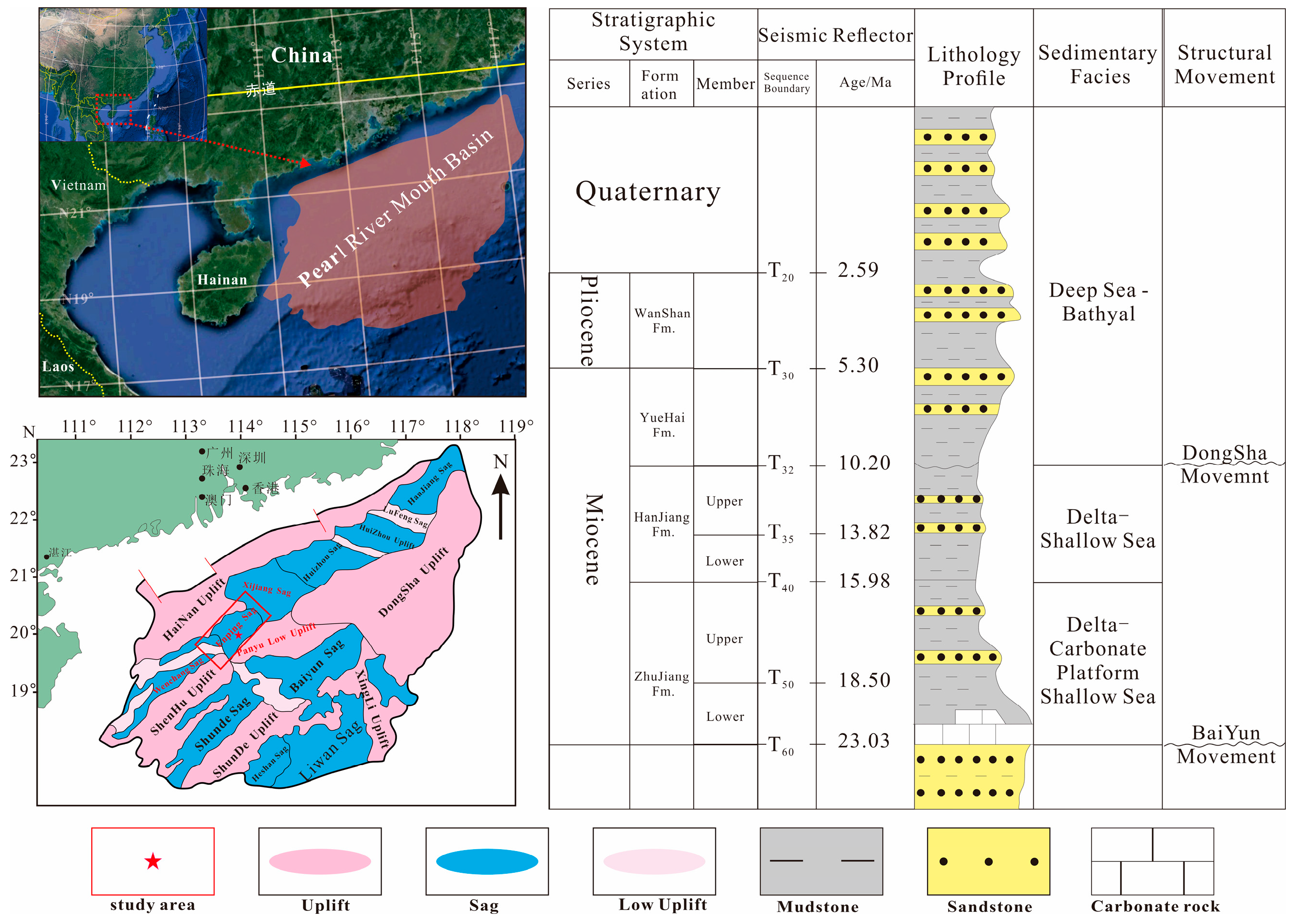
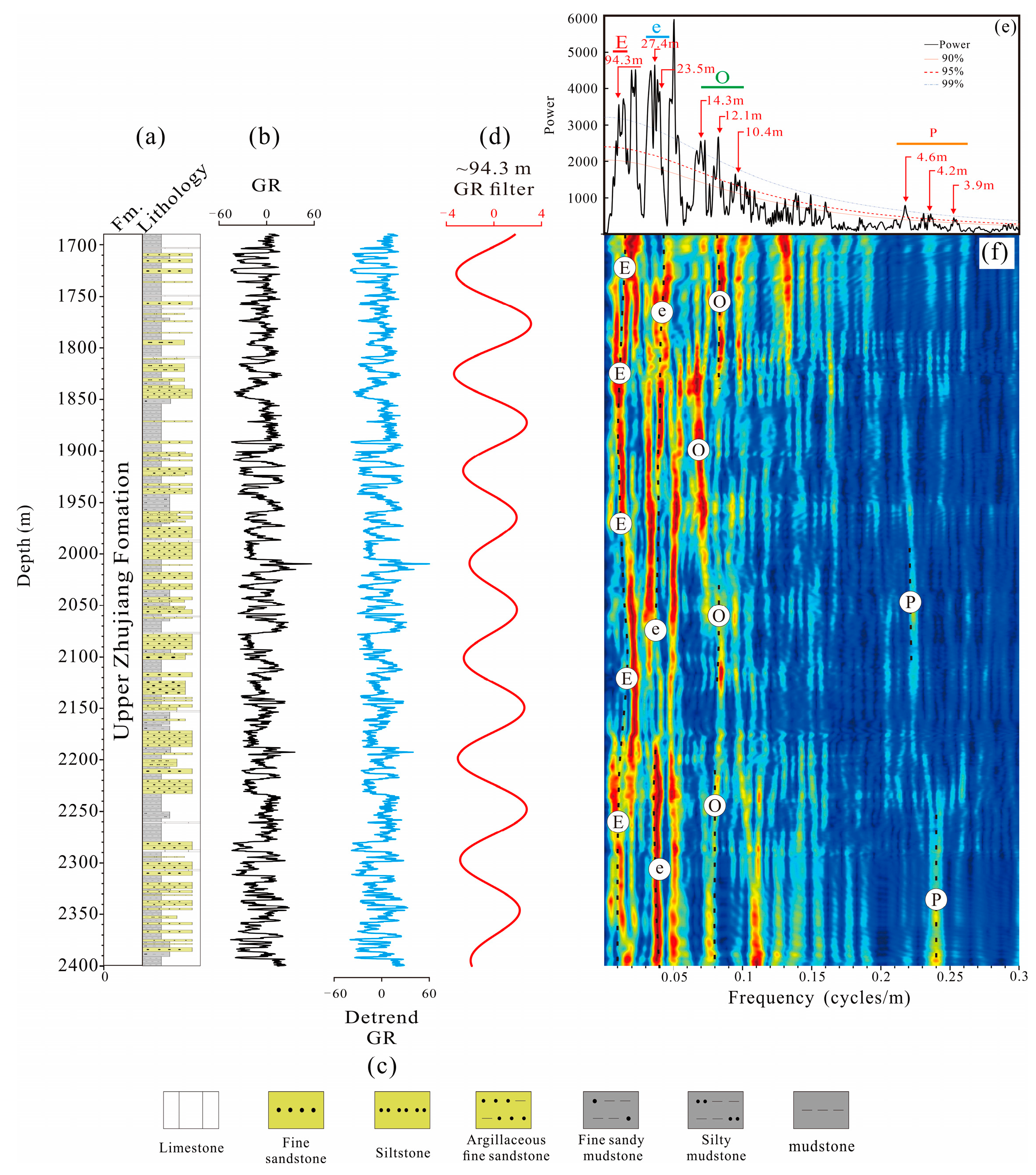

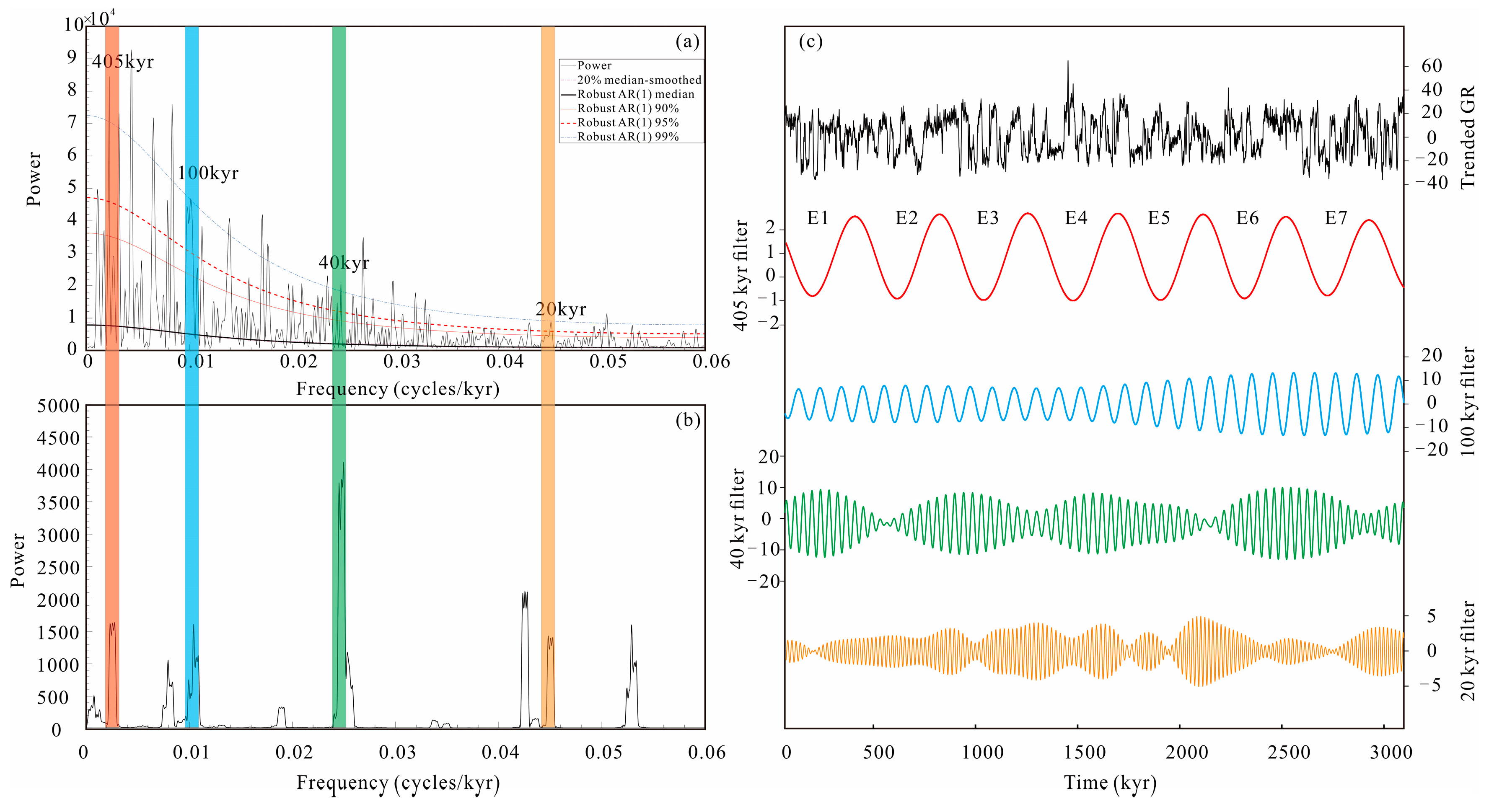
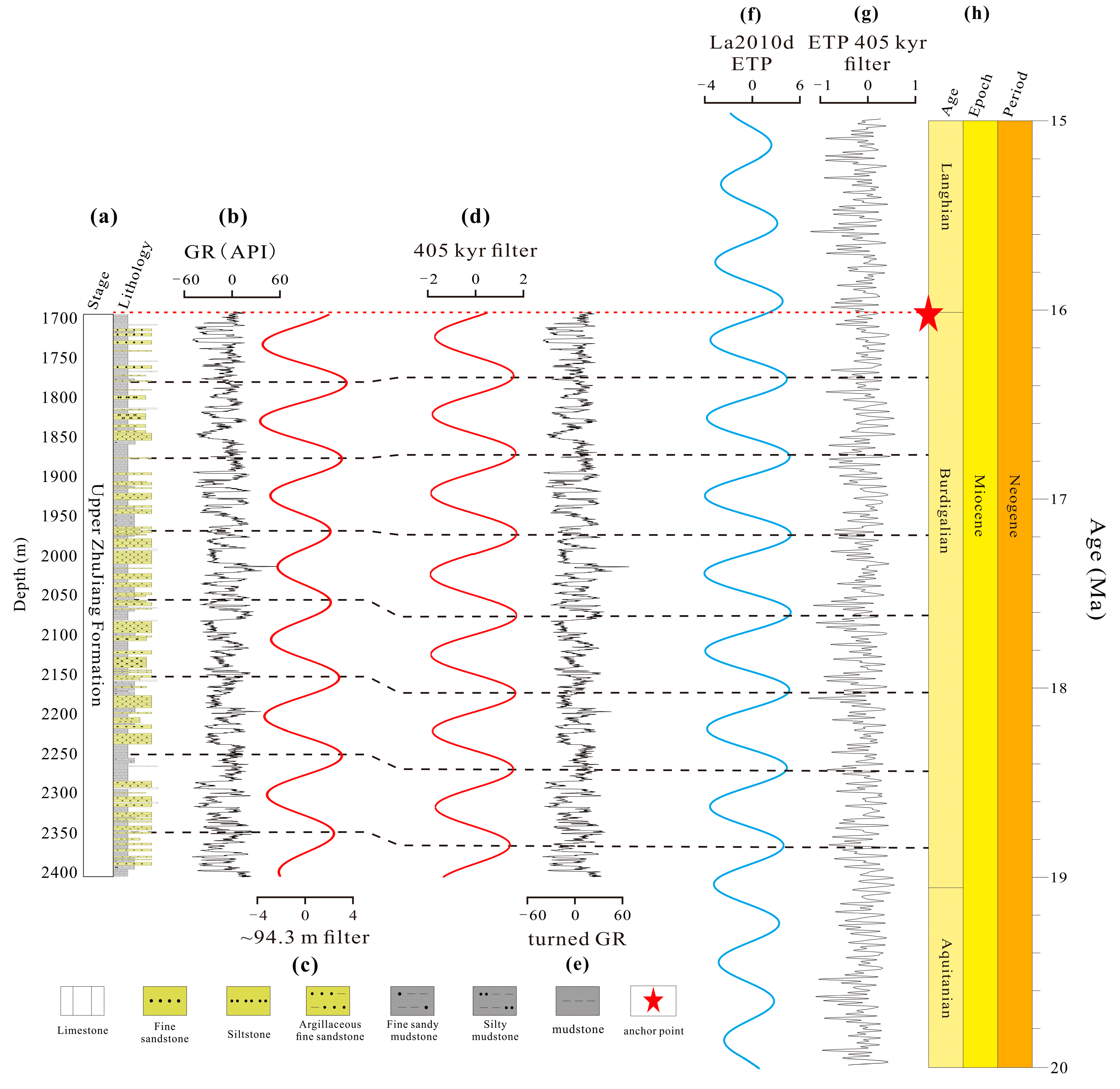
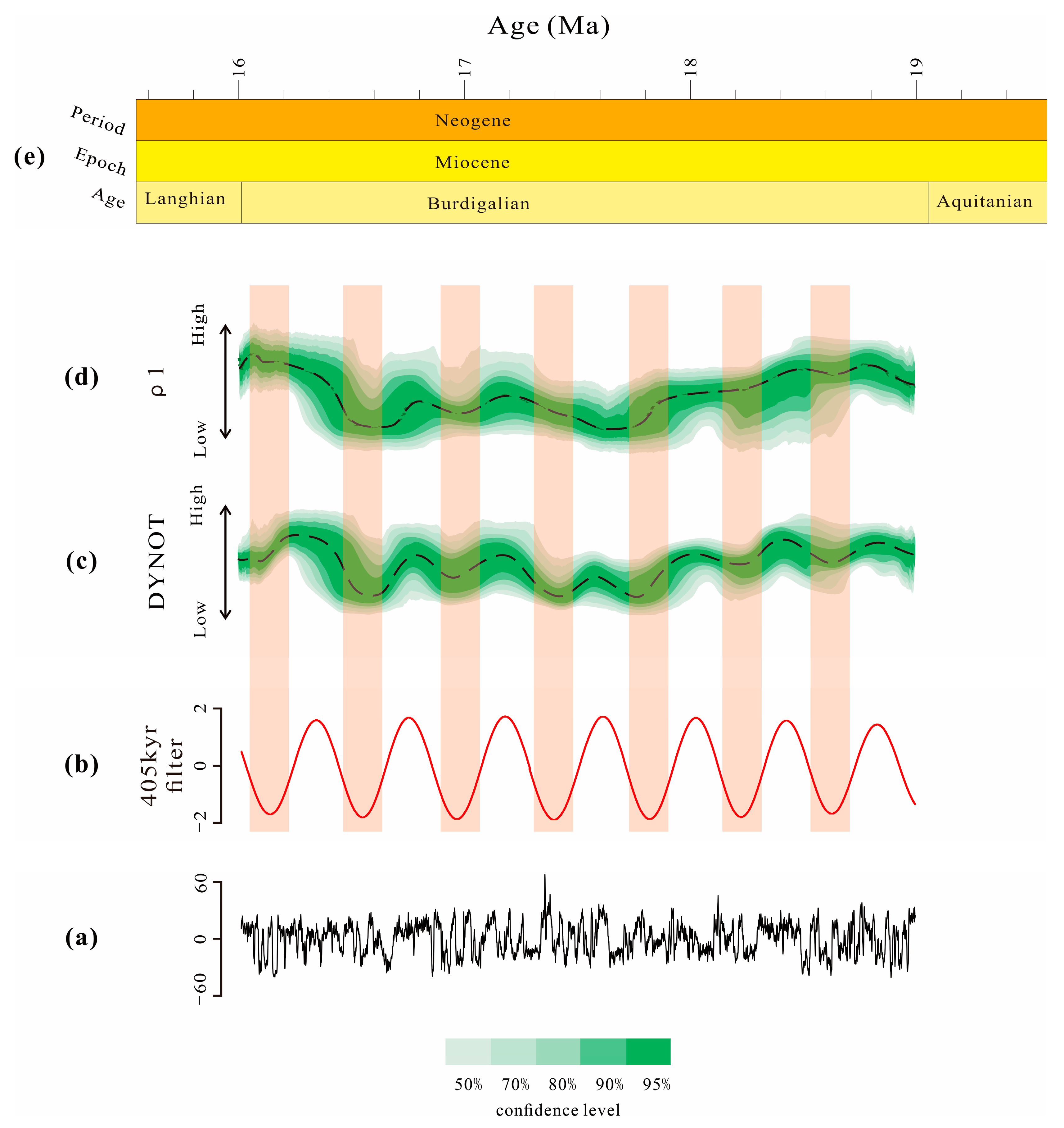
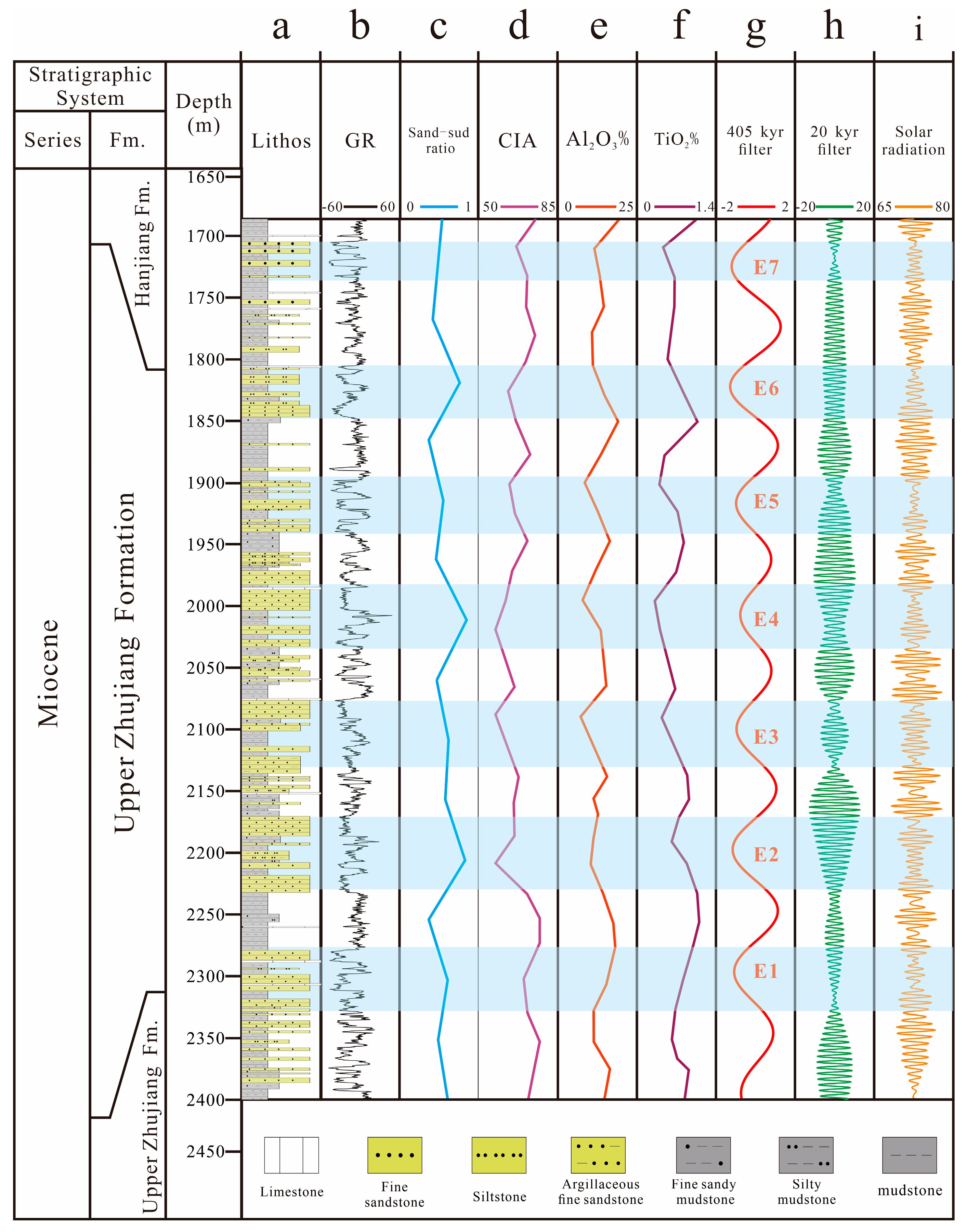

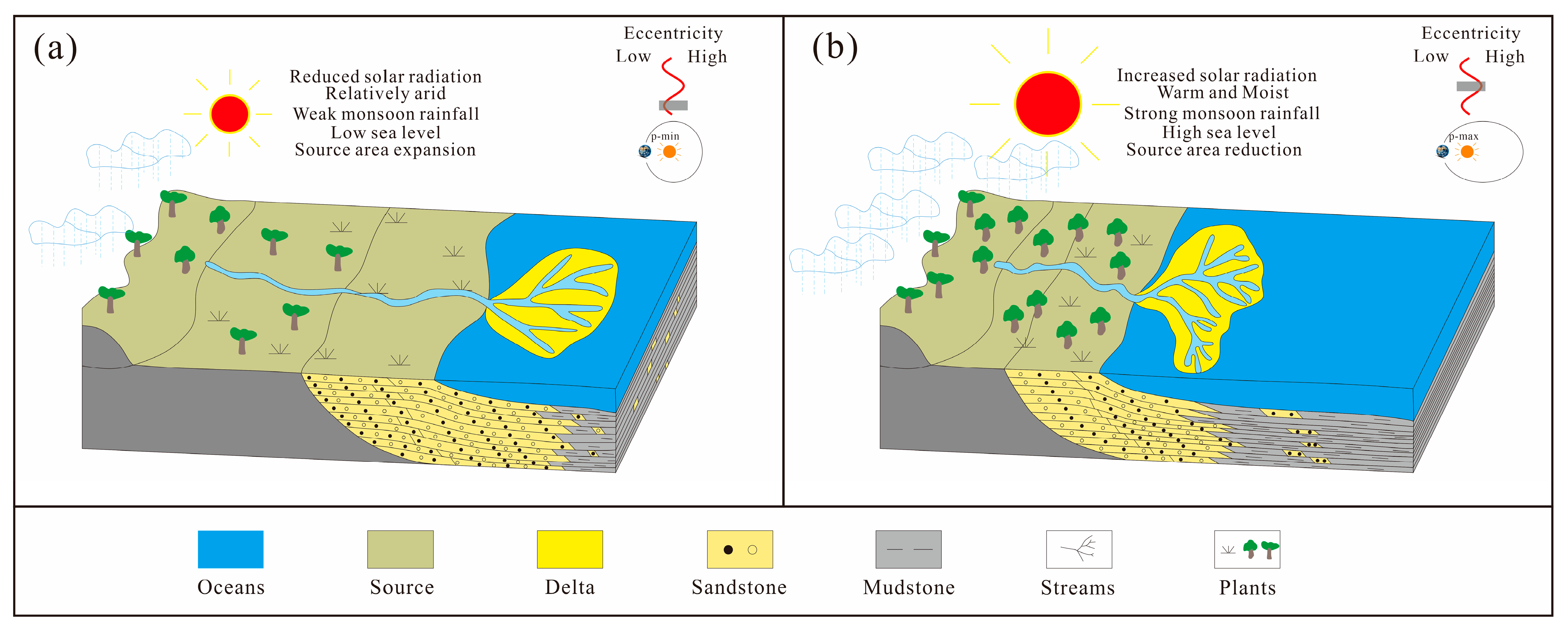
Disclaimer/Publisher’s Note: The statements, opinions and data contained in all publications are solely those of the individual author(s) and contributor(s) and not of MDPI and/or the editor(s). MDPI and/or the editor(s) disclaim responsibility for any injury to people or property resulting from any ideas, methods, instructions or products referred to in the content. |
© 2025 by the authors. Licensee MDPI, Basel, Switzerland. This article is an open access article distributed under the terms and conditions of the Creative Commons Attribution (CC BY) license (https://creativecommons.org/licenses/by/4.0/).
Share and Cite
Zhang, S.; Zeng, C.; Xu, E.; Wang, Y.; Zhu, R.; Han, R.; Gong, G. Astronomical Orbital Cycle-Driven Coevolution of Paleoclimate and Sea Level with Sedimentary Response: A Case Study from the Upper Member of the Miocene Zhujiang Formation in the Enping Depression, South China Sea. Appl. Sci. 2025, 15, 5922. https://doi.org/10.3390/app15115922
Zhang S, Zeng C, Xu E, Wang Y, Zhu R, Han R, Gong G. Astronomical Orbital Cycle-Driven Coevolution of Paleoclimate and Sea Level with Sedimentary Response: A Case Study from the Upper Member of the Miocene Zhujiang Formation in the Enping Depression, South China Sea. Applied Sciences. 2025; 15(11):5922. https://doi.org/10.3390/app15115922
Chicago/Turabian StyleZhang, Shangfeng, Chenjun Zeng, Enze Xu, Yaning Wang, Rui Zhu, Rui Han, and Gaoyang Gong. 2025. "Astronomical Orbital Cycle-Driven Coevolution of Paleoclimate and Sea Level with Sedimentary Response: A Case Study from the Upper Member of the Miocene Zhujiang Formation in the Enping Depression, South China Sea" Applied Sciences 15, no. 11: 5922. https://doi.org/10.3390/app15115922
APA StyleZhang, S., Zeng, C., Xu, E., Wang, Y., Zhu, R., Han, R., & Gong, G. (2025). Astronomical Orbital Cycle-Driven Coevolution of Paleoclimate and Sea Level with Sedimentary Response: A Case Study from the Upper Member of the Miocene Zhujiang Formation in the Enping Depression, South China Sea. Applied Sciences, 15(11), 5922. https://doi.org/10.3390/app15115922





